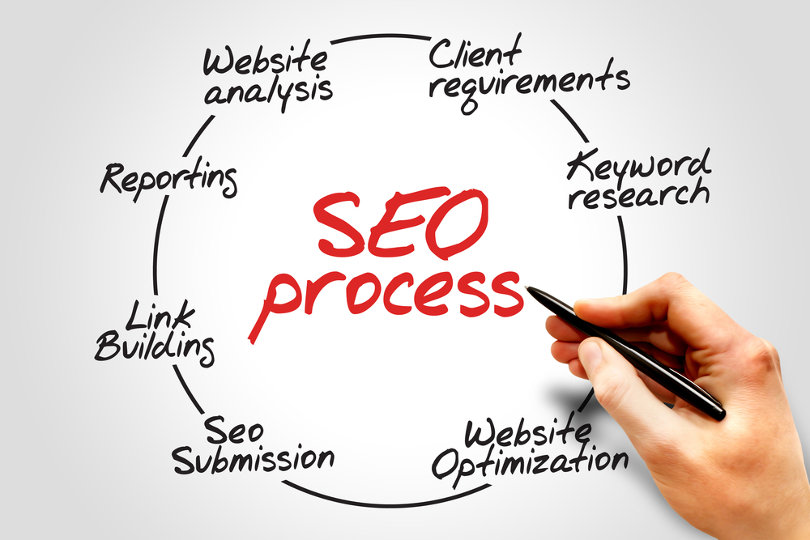There are a ton of different variables that play into the success or failure of a company’s SEO, but one thing is for sure- it takes time to see results. Beware of anyone who promises to put your business on the front page of Google immediately; if it sounds too good to be true, it probably is. That being said, you WILL start to see results after about a month….but they won’t be as good as the ones you’ll see after 6 months, or after a year.
SEO is like a fine wine- it only gets better with time!

The 3 Main Types of SEO
There are three main ways your site can receive traffic- via map listings, through organic search results, and by using pay-per-click (PPC) campaigns. Google Maps and other map applications make it easy for people to find local businesses, and they typically link directly back to the business’s website making it an easy way to drive new traffic to your site. The organic search uses an algorithm to determine which websites rank in order when a keyword is typed into a search engine. PPC campaigns are paid campaigns that companies use to increase their rankings via paid advertisements.
The type of SEO results you’re looking for, whether they be local, national, or global, will also impact your timeline.
If you’re a brand new business with a new website and without a lot of search history it will take longer for you to see results.
It also takes time for user behavior to change. It may take a while for consumers to notice you’ve made changes to your website. Wondering exactly how you can improve the user experience on your website?

How SEO Works
According to Forbes, some people are misinformed because SEO doesn’t work the same way that it used to. It used to be that SEO was all about keywords- identifying which ones got the most traffic and were most relevant to your type of business. But nowadays SEO is about so much more than keyword strategy; it’s almost impossible to rank well solely by focusing on 5 or 10 high traffic keywords. This is because people have changed the way they use search engines. In the past they would type in one or two words when searching, such as “pizza place”, whereas now users type full-on questions and sentences, similar to the way we speak (ie: “what is the closest pizza place to my location”). This is called natural language search, and it has completely changed SEO strategy.
Another thing to consider is the value of rankings. What good is being listed #1 on Google if all the traffic going to your site isn’t resulting in conversions? Who cares if you get thousands of website visitors every day if they aren’t leaving their email address, or making purchases? When coming up with a game plan for SEO, make sure you consider ALL your long-term goals, and not just putting the most emphasis on your rankings.
Your domain name also plays a huge role in SEO. It should definitely contain keywords, but even that isn’t enough. Do some research into your name before settling; consider if it’s used by other businesses, or has been in the past- this could potentially hurt your rankings or prolong your efforts to draw new traffic.

The Timeline
All of these variables considered, most businesses will start to see results in 4-6 months.
RefreshWeb suggests users follow this 9-month timeline.
The first month should be all about research and planning. Come up with your short and long-term goals, look at what your competitors are doing, and start working on a keyword strategy. You shouldn’t be making any major changes to your website within the first month. Your site audit should take anywhere from 2-4 weeks.
After you’ve compiled your research (on your own site as well as your competition) you can start making technical changes to your site. For some people, this will be quick and easy- a matter of changing your website layout or adding more CTAs. For others, it might mean a complete site overhaul. Things like content creation and link building take time, so take this into account when considering your SEO timeline. The more work your site needs, the longer it will take to see results. An average timeline for this would be 1-2 months.
Once you’ve re-configured your website you can start working on content creation, ideally somewhere around the 3rd or 4th month depending on how much work your website needs. Content creation will probably take around 2 months to implement.
By the 5th month you should start seeing some results in terms of ranking and website traffic, but keep in mind it won’t be anywhere near the success you should have at the end of a year. At this point, if you haven’t done so already you can start incorporating social media into your strategy. Social media is a great way to organically direct people back to your website and increase your traffic. If your leads haven’t increased after ramping up your social strategy you should definitely revisit your plan and possibly consult a social media management company. This is also a good time to work on your link acquisition efforts, which could take anywhere from 3 to 4 months to implement effectively.
At the end of the 6th month, you should hopefully have come close to meeting your goals for website traffic and rankings. If that’s the case then you should continue to focus on content creation and social media management, but Forbes says it’s also ok to take a few creative risks and see where you end up.

The Takeaway
If you have a strong number of followers, one or two changes (whether good or bad) won’t ruin months of hard work, so don’t be afraid to think outside the box! Just remember to always monitor your results so that you know if your efforts are working and you can revisit your strategy if they’re not.
Have you effectively overhauled your website in order to improve your SEO? What were your goals and how did they fit in with your timeline? Comment in the section below!




